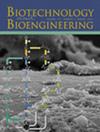ETV2 Overexpression Promotes Efficient Differentiation of Pluripotent Stem Cells to Endothelial Cells
IF 3.5
2区 生物学
Q2 BIOTECHNOLOGY & APPLIED MICROBIOLOGY
引用次数: 0
Abstract
Differentiating endothelial cells (ECs) from human pluripotent stem cells (hPSCs) typically takes 2 weeks and requires parameter optimization. Overexpression of cell type-specific transcription factors in hPSCs has shown efficient differentiation into various cell types. ETV2, a crucial transcription factor for endothelial fate, can be overexpressed in hPSCs to induce rapid and facile EC differentiation (iETV2-ECs). We developed a two-stage strategy which involves differentiating inducible ETV2-overexpressing hPSCs in a basal induction medium during stage I and expanding them in an endothelial medium during stage II. By optimizing seeding density and medium composition, we achieved 99% pure CD31+ CD144+ iETV2-ECs without cell sorting in 5 days. iETV2-ECs demonstrated in vitro angiogenesis potential, LDL uptake, and cytokine response. Transcriptomic comparisons revealed similar gene expression profiles between iETV2-ECs and traditionally differentiated ECs. Additionally, iETV2-ECs responded to Wnt signaling agonist and TGFβ inhibitor to acquire brain EC phenotypes, making them a scalable EC source for applications including blood-brain barrier modeling.从人多能干细胞(hPSCs)分化出内皮细胞(ECs)通常需要两周时间,而且需要优化参数。在hPSCs中过表达细胞类型特异性转录因子可高效分化成各种细胞类型。ETV2是决定内皮命运的关键转录因子,在hPSCs中过表达可诱导快速、简便的EC分化(iETV2-ECs)。我们开发了一种两阶段策略,即第一阶段在基础诱导培养基中分化诱导性 ETV2-过表达 hPSCs,第二阶段在内皮培养基中扩增它们。通过优化播种密度和培养基成分,我们在5天内就获得了99%纯度的CD31+ CD144+ iETV2-ECs,而无需进行细胞分拣。iETV2-ECs表现出体外血管生成潜能、低密度脂蛋白摄取和细胞因子反应。转录组比较显示,iETV2-ECs 和传统分化 ECs 的基因表达谱相似。此外,iETV2-ECs 对 Wnt 信号激动剂和 TGFβ 抑制剂有反应,获得了脑 EC 表型,使其成为血脑屏障建模等应用的可扩展 EC 来源。
本文章由计算机程序翻译,如有差异,请以英文原文为准。
求助全文
约1分钟内获得全文
求助全文
来源期刊

Biotechnology and Bioengineering
工程技术-生物工程与应用微生物
CiteScore
7.90
自引率
5.30%
发文量
280
审稿时长
2.1 months
期刊介绍:
Biotechnology & Bioengineering publishes Perspectives, Articles, Reviews, Mini-Reviews, and Communications to the Editor that embrace all aspects of biotechnology. These include:
-Enzyme systems and their applications, including enzyme reactors, purification, and applied aspects of protein engineering
-Animal-cell biotechnology, including media development
-Applied aspects of cellular physiology, metabolism, and energetics
-Biocatalysis and applied enzymology, including enzyme reactors, protein engineering, and nanobiotechnology
-Biothermodynamics
-Biofuels, including biomass and renewable resource engineering
-Biomaterials, including delivery systems and materials for tissue engineering
-Bioprocess engineering, including kinetics and modeling of biological systems, transport phenomena in bioreactors, bioreactor design, monitoring, and control
-Biosensors and instrumentation
-Computational and systems biology, including bioinformatics and genomic/proteomic studies
-Environmental biotechnology, including biofilms, algal systems, and bioremediation
-Metabolic and cellular engineering
-Plant-cell biotechnology
-Spectroscopic and other analytical techniques for biotechnological applications
-Synthetic biology
-Tissue engineering, stem-cell bioengineering, regenerative medicine, gene therapy and delivery systems
The editors will consider papers for publication based on novelty, their immediate or future impact on biotechnological processes, and their contribution to the advancement of biochemical engineering science. Submission of papers dealing with routine aspects of bioprocessing, description of established equipment, and routine applications of established methodologies (e.g., control strategies, modeling, experimental methods) is discouraged. Theoretical papers will be judged based on the novelty of the approach and their potential impact, or on their novel capability to predict and elucidate experimental observations.
 求助内容:
求助内容: 应助结果提醒方式:
应助结果提醒方式:


